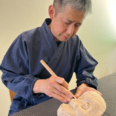
Caltech scientists are actively studying how to seamlessly integrate technology—things like sensors, actuators, and microprocessors, but also novel materials—into things that we wear. And the social media and technology company Meta Platforms, Inc. (Meta), has spent the past 10 years pushing forward the development of virtual, augmented, and mixed reality technologies, while also investigating the basic science underlying wearable technologies.
Now Caltech and Meta have formalized an agreement that will bring together the Institute’s innovative research approach in areas such as materials science, human–computer interfaces, sensing and tracking, and machine learning, with Meta research projects exploring how people interact with integrated technologies. As part of the agreement, Meta has renovated and opened a 1600 square foot research lab on campus, with a campus faculty lead, and is investing in a variety of research projects at the Institute through a grant-making fund. The new partnership will initially focus on the science underlying smart wearables but could extend to other areas of shared interest.
Chiara Daraio, the G. Bradford Jones Professor of Mechanical Engineering and Applied Physics, who is currently on leave as a Meta research scientist, leads the effort. For the past several years, she has been collaborating with Meta and has seen first-hand the opportunities that Meta has to offer in working with the Institute.
“Caltech excels at fundamental science—tackling hard, interdisciplinary questions and coming up with creative solutions,” says Daraio, also a Heritage Medical Research Institute Investigator. “Meta needs to solve precisely these kinds of deep scientific challenges, driven by the desire to build revolutionary technologies. To meet these needs, Meta brings to Caltech new intellectual challenges and a long-term vision to support foundational research and achieve breakthroughs together.”
Looking to the future, Daraio imagines that much of what we wear will become ever-more intelligent. This naturally leads to fascinating new questions for scientists: What new materials will allow us to integrate hardware technologies into wearables, while ensuring that they remain comfortable, effective, and durable? How do we make sense of inputs coming from multiple sensors to provide data that is ultimately useful to the wearer? How can we make electronic computing devices fit more seamlessly into daily life?
“These are fundamental questions, which offer plenty of space for interdisciplinary scientific inquiry and engineering advancements,” Daraio says. “This is an exciting opportunity for the Caltech community. As a campus, we are small but mighty. In terms of intellectual capabilities, curiosity, and creativity, we have a lot to offer. And, in return, we can be inspired by new tech needs, applications-driven challenges, and, of course, resources that this agreement will make available to the campus at large.”
Meta On Campus
A handful of Meta researchers moved into the new campus-based research lab at the end of March. Located in the Beckman Institute, the new research space was renovated to include workspaces, conference rooms, and two labs equipped for experimental research on sensing and haptics, the science of generating a sensation of touch through force or motions such as vibrations. Additional Meta team members are expected to arrive and begin working on campus in the coming months. Importantly, Caltech students, postdoctoral scholars, staff, and faculty members who partner with Meta will have the opportunity to work collaboratively with Meta research scientists, use Meta equipment, and intern in the Meta space on campus.
At the same time, Meta is offering calls for proposals to Caltech researchers, including for gift and sponsored research projects. There are also plans to host a joint seminar series or symposium to get students and researchers mixing and discussing challenges and opportunities that exist on the computing and experimental sides of the work.
Meta-Funded Projects
Meta has a track record of funding Caltech research, and these new projects carry on that tradition.
One of the Meta-funded projects is led by Domniki Asimaki, professor of mechanical and civil engineering, along with Daraio and Kaushik Bhattacharya, the Howell N. Tyson, Sr., Professor of Mechanics and Materials Science. They are working to understand how ultrasound waves propagate on the skin, especially when a force or pulse is applied. “Studies like ours can help us better understand how to use ultrasound tests to interpret touch signals,” Asimaki says.
In another Meta-funded project, Wei Gao, professor of medical engineering, is developing the next generation of emotionally intelligent wearables that combine soft bioelectronics with adaptive haptic interfaces.
“Support from Meta is accelerating the translation of physiological insights into immersive, therapeutic augmented reality experiences that are both personalized and scalable,” says Gao, who is also a Heritage Medical Research Institute Investigator and a Ronald and JoAnne Willens Scholar.
Partnering with Industry
In recent years, Caltech has sought to expand interactions with industry to further the impact, development, and reach of fundamental science research in areas where there is a strong match between the Institute’s work and a company’s pursuits, says Fred Farina, Caltech’s chief innovation and corporate partnerships officer. “This collaboration with Meta is a good example of this type of partnership. We’re interested in fundamental research and pushing the boundaries of knowledge, and they’re obviously interested in bringing novel technologies and products to the marketplace,” he says. “We’re also interested in impact in the world and society through these new products and services. And to have that impact, we need to partner with industry.”
The new partnership was designed to be able to quickly respond as new questions arise from the research. The collaboration creates an umbrella framework that covers multiple research areas, effectively streamlining the process to create sponsored projects between Caltech and Meta moving forward. “Hopefully, when there are mutual interests that spark an idea, it can very quickly turn into a collaboration and project,” Daraio says. “There is a lot of enthusiasm on both sides of this agreement.”














 1 comment
1 comment


